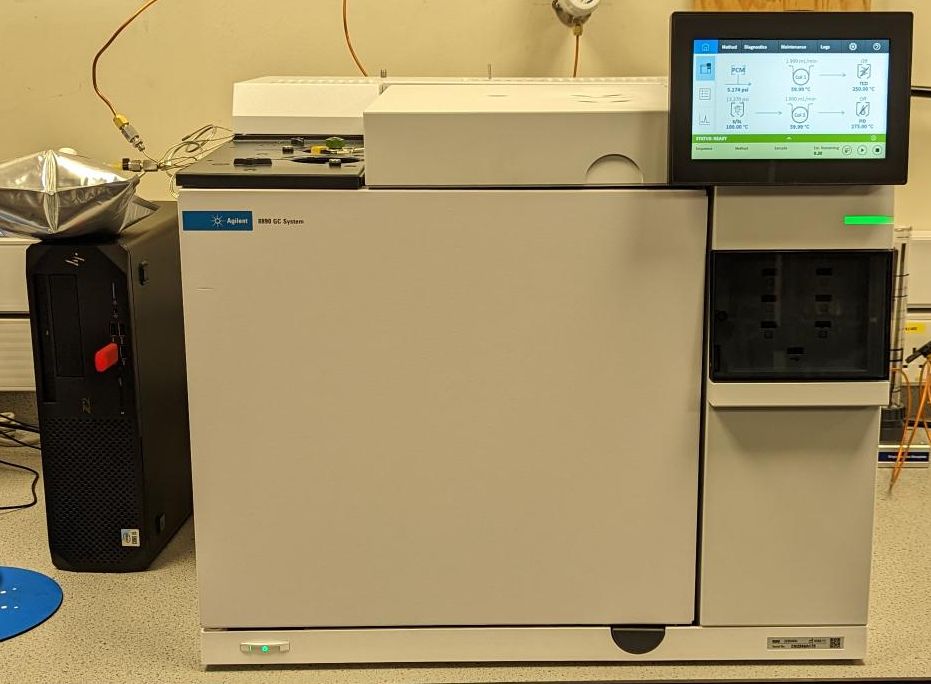GC-TCD-FID Gas Analysis
 GC-TCD-FID is used to analyse and quantify gases and lower molecular weight volatile species. which includes permanent gases and organic gases. LPD Lab Services has a Gas Chromatograph GC with a TCD Thermal Conductivity Detector and a FID Flame Ionisation Detector. This allows investigation of various different analyte gases and liquids and concentration ranges building on the GC-MS, Pyrolysis GC-MS, FTIR, HPLC and other chemical analysis capabilities that can be applied to liquids and solids at the laboratory.
GC-TCD-FID is used to analyse and quantify gases and lower molecular weight volatile species. which includes permanent gases and organic gases. LPD Lab Services has a Gas Chromatograph GC with a TCD Thermal Conductivity Detector and a FID Flame Ionisation Detector. This allows investigation of various different analyte gases and liquids and concentration ranges building on the GC-MS, Pyrolysis GC-MS, FTIR, HPLC and other chemical analysis capabilities that can be applied to liquids and solids at the laboratory.
GC- TCD-FID Applications for Clean Gas and Liquid Injections
Samples for GC-TCD-FID can be supplied in Tedlar bags, headspace vials, cylinders and for liquid injections. Applications include:
- Analysis of most gases for contaminants and assess gas purity.
- Analyse off gas from volatile samples directly or off-gassing components indirectly.
- Analyse combustion gases from TGA or pyrolysis in different reactant gases environments after collection on an absorbent.
- Analysis of permanent gases including purity of industrial and speciality gases.
- Contaminant identification in air, mediacal and environmental sectors.
- Measure trace water content in some solvents and gases. Higher water contents can be measured by Karl Fischer titrations.
- Dissolved gases in hydrocarbons.
The TCD will detect both inorganic and organic gases including permanent gases, limited of organic components C1 up to C6 molecules and inorganic gases plus with additional instrument protection corrosive gases too.
The FID is able to detect a wide range of carbon-containing organic gases although its sensitivity to hydrocarbons can be more limited by the presence of hetero-atoms such as chlorine, fluorine, bromine, oxygen, nitrogen and silicon in the gas molecular structure.
GC-TCD-FID Instrument
The laboratory’s GC-TCD-FID instrument is an Agilent 8890GC which is essentially a heating oven with advanced pneumatics with heated gas sampling valves. The instrument has both a TCD Thermal Conductivity Detector and a FID Flame Ionisation Detector to allow analysis of different analyte gases and liquids.
- The TCD is a Non-specific detector based on thermal conductivity. It works on the differences between the thermal conductivity of the analyte gas relative to the carrier gas. TCD cannot look for signature differences for specific gases so calibration gases are required for identification separated by characteristic retention times within the analytical column.
- The FID involves detection by ionisation in a combustion flame. It provides a very high almost linear response giving a dynamic range from high concentrationsdown to low concentrations. The FID requires calibration gases for identifications based on retention times too.
Retention times are fixed for specific analytes for a given column type allowing reliable intermittent repeat samples and batches to be handled permitting routine analysis programs of work to be undertaken.
Sample Gas and Liquid Introduction and Sample Types
- Samples can be introduced as gases via loop inlets using small gas bottles, Swagelock gas bottles of sealed volumes, gas bags and gas syringes and liquids via direct injection.
- Sample loops include volumes of 5ul,150ul, 1000ul.
- Automated samples can be run by liquid or headspace injection but gas sampling is manual injection.
- Gases cannot be introduced directly into the sample loops that may block the system such as from aerosols or where dirty samples, vapours dusts and particulates may be involved. These sort of samples require bespoke method and sampling development.


